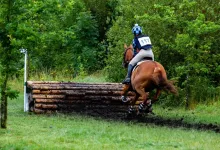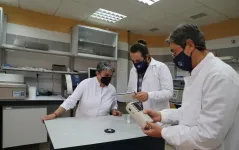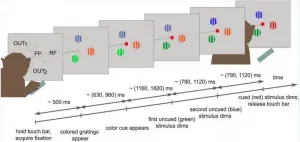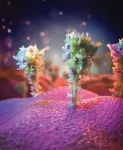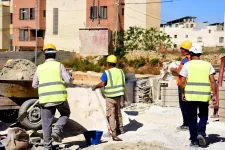(Press-News.org) The landscape of sloping vineyards on the banks of the River Mosel in Germany is a characteristic symbol of a region, which cannot be understood without its wine: the Mosel wine region. Tourists from all over the world, especially from the neighbouring countries of Belgium, Luxembourg, and The Netherlands visit the area in search of mountains and wine. However, the lack of new generations and the increase in temperatures and short heavy summer rainfall events caused by climate change endanger the production of wine.
In this sense, the European H2020 Diverfarming Project began in 2018 the diversification of a steep-slope, very stony (up to 70%) ecological vineyard. In the majority of the vineyards, the introduction of herbaceous species for plant cover has become widespread, with herbaceous plants in the alleys between the grapevines, but beneath them, it is combated with herbicides or mechanically. With the aim of reducing soil erosion, increasing soil fertility, and mitigating the effects of greenhouse-gas emissions, a team of researchers from the Trier University (Germany) coordinated by Professor Manuel Seeger and Professor Sören Thiele-Bruhn put into practice the introduction of aromatic plants (thyme and oregano) beneath the grapevines of the 'Weingut Dr. Frey' wine-making company.
After three years of diversification the team formed by the researchers Felix Dittrich, Thomas Iserloh, Roman Hüppi, Sophie Ogan, Sören Thiele-Bruhn, Manuel Seeger, and the winemaking entrepreneur Cord Treseler have published the first results of the diversification on the productivity of the grapevines and the quality of the wine. These results show the potential possibilities that these practices have since they have not generated negative effects in the wine production.
Although a certain amount of competition was observed between the aromatic cover and the grapevines for water and nutrients, these effects far from being negative, give rise to thinking that they may have a positive effect on the quality of the wine, as the researcher Manuel Seeger comments. This is related to the reduction of certain nutrients: while the availability of nitrate had no change in the crop diversification, the ammonium, phosphorus, and potassium levels did decrease in the uppermost area of the soil (the first 10 cm). However, it is known that there is a certain relationship between available potassium and wine quality. The results of this study point out that a change in the availability of the mineral acidity of the soil would seem to generate an increase in the quality of these wines. Moreover, the principle of yield compensation was observed: although the yield of the grapevine is slightly lower, this is compensated by an increase in quality.
The study highlights the extreme events at climate level that have taken place over the three years of the diversification. In 2018, storms produced one month's volume of rainfall in the zone in just one hour; whilst in 2019 and 2020 there were record high temperatures and drought. In this way, it is clear that the availability of water and the climate conditions are the most determining factor for the productivity of the vineyard. Despite that being the case, if we take the extreme conditions into account, the diversification has had no negative effects on the yield of the crop or on the quality of the wine. In standardised situations and with the long-term stabilisation of the diversification this opens the door to an increase in profits thanks to the diversification.
The conservation of the characteristic landscape of the zone, the reduction in contaminant emissions, and the increase in biodiversity both in the soil as well as in other organisms such as insects will contribute added value to this sector, which is currently open to changes that enable it to face this lack of a generational substitution and the scenarios which the effects of climate change are expected to bring. All of this is to save the future of the Mosel wine.
INFORMATION:
Diverfarming is a project financed by the Horizon 2020 Programme of the European Commission, within the challenge of "Food Security, Sustainable Agriculture and Forestry, Marine, Maritime and Inland Water Research and the Bioeconomy" under agreement 728003, and which counts on the participation of the Universities of Cartagena and Córdoba (Spain), Tuscia (Italy), Exeter and Portsmouth (United Kingdom), Wageningen (Netherlands), Trier (Germany), Pecs (Hungary) and ETH Zurich (Switzerland), the research centres Consiglio per la ricerca in agricoltura e l'analisi dell'economia agraria (Italy), the Consejo Superior de Investigaciones Científicas (Spain) and the Natural Resources Institute LUKE (Finland), the agrarian organisation ASAJA, and the companies Casalasco and Barilla (Italy), Arento, LogísticaDFM and Industrias David (Spain), Nieuw Bromo Van Tilburg and Ekoboerdeij de Lingehof (Netherlands), Weingut Dr. Frey (Germany), Nedel-Market KFT and Gere (Hungary) and Paavolan Kotijuustola and Polven Juustola (Finland).
It was found that event horses that wear thin or thick bits in events had a greater risk of moderate or severe oral lesions compared to horses wearing medium-sized bits, while straight bits were associated with lesions in the bars of the horse's mouth.
"Our recommendation is to use a jointed bit of moderate thickness, that is 14 to 17 millimetres, if the size of the mouth is not known, paying particular attention to the handling of mares and both warmblood and coldblood event horses. They were seen to have a greater risk of mouth lesions compared to geldings and ponies," says doctoral student and veterinarian ...
The global production of sheep's milk is one the rise, in the vast majority of cases used to produce cheese. However, a relatively large amount of milk is needed to produce it, so science is looking for ways to increase its yield; that is, to obtain more cheese using less milk.
Immersed in this task, a team from the Department of Animal Production at the University of Cordoba, led by Professor Ana Garzón, has collaborated with the University of Leon in the search for genetic parameters affecting the cheese production of milk from Churra sheep, one of the oldest and most rustic breeds on the Iberian Peninsula.
After analysing traits related to rennet and milk properties (pH, ...
The way we move says a lot about the state of our brain. While normal motor behaviour points to a healthy brain function, deviations can indicate impairments owing to neurological diseases. The observation and evaluation of movement patterns is therefore part of basic research, and is likewise one of the most important instruments for non-invasive diagnostics in clinical applications. Under the leadership of computer scientist Prof. Dr Björn Ommer and in collaboration with researchers from Switzerland, a new computer-based approach in this context has been developed at Heidelberg University. As studies inter alia with human test persons have shown, this approach enables the fully automatic ...
It is more complicated than copy and paste, but digital twins could be way of future manufacturing according to researchers from the University of Kentucky. They developed a virtual environment based on human-robot interactions that can mirror the physical set up of a welder and their project. Called a digital twin, the prototype has implications for evolving manufacturing systems and training novice welders. They published their work in the IEEE/CAA Journal of Automatica Sinica (Volume 8, Issue 2, February 2021).
"This human-robot interaction working style helps to enhance the human users' operational productivity and ...
To effectively perform any daily task, the human brain needs to process information from the outside world using various cognitive functions. This cognitive processing passes through a dense interconnected network of cells whose physiology is specialized. The interconnected cell network needs to perform this processing of information efficiently and interact cooperatively to provide us, in real time, with useful instructions for living.
Research published on 23 March in the journal Proceedings of the National Academy of Sciences of the United States of America challenges recent scientific advances seeking to find out how cognitive control and sensory information relate to the cortical machinery ...
New research has for the first time compared images of the protein spikes that develop on the surface of cells exposed to the Oxford-AstraZeneca vaccine to the protein spike of the SARS-CoV-19 coronavirus. The images show that the spikes are highly similar to those of the virus and support the modified adenovirus used in the vaccine as a leading platform to combat COVID-19.
The SARS-CoV-2 virus, which causes COVID-19, has a large number of spikes sticking out of its surface that it uses to attach to, and enter, cells in the human body. These spikes are coated in sugars, known as ...
Researchers at the Francis Crick Institute, as part of an international collaboration of scientists through the Pan-Cancer Analysis of Whole Genomes Consortium, have analysed the whole genomes of tumour samples from over 2,600 patients with different types of cancer. They identified a high prevalence of genetic diversity within individual tumours, which they further characterised. Their findings confirm that, even at late stages of development, tumour evolution is driven by changes that benefit the cancer.
When cancer cells divide, errors occur in the process of copying their DNA. These copying errors mean that different tumours can be made up of cells presenting a wide range of genetic diversity. This variation is a challenge for doctors as a treatment that ...
Digitalisation can support transitions towards a more sustainable society if technologies and processes are designed in line with suitable criteria. This requires a systemic focus on the risks and benefits of digital technologies across the three dimensions of sustainable development: the environment, society, and the economy. This is the conclusion of a study prepared by a team of researchers at the Institute for Advanced Sustainability Studies (IASS) in Potsdam. Applying this precautionary approach to digitalisation requires the active involvement of developers, users, and regulators.
Digitalisation ...
ALS is a progressive neurological disease that attacks the nerves that interact with the body's muscles. The disease typically leads to complete paralysis of the body, robbing patients of their ability to walk, speak, eat and breathe.
Researchers studied ALS patients and healthy elderly volunteers living in Malta who took part in an ongoing study aiming at identifying genetic and environmental risk factors. Malta is a sovereign microstate in the middle of the Mediterranean Sea, and is home to a geographically and culturally isolated population. Recently, Maltese ALS patients were found to have a unique genetic makeup compared to ...
Bishop Peder Winstrup died in 1679, and is one of the most well-preserved human bodies from the 1600s. Researchers at Lund University in Sweden may now have solved the mystery of why a foetus was hidden in his coffin in Lund Cathedral. DNA from the bishop and the foetus, along with kinship analyses, has shown that the child was probably the bishop's own grandson.
Something is protruding between Bishop Peder Winstrup's two calves. The X-ray reveals small bones. Could it be an animal? When the image is studied more closely, the osteologists from Lund University can see faint signs of what is to become ...

